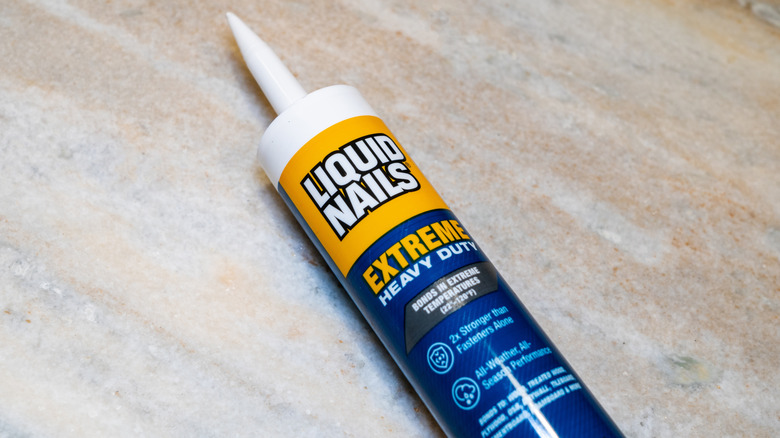How To Determine Whether To Use Wood Glue Or Liquid Nails For Your Home Project
We may receive a commission on purchases made from links.
Whether you're planning to get started on a personal woodworking project or you're doing some DIY construction around the home, it's essential to know the best glues and adhesive for homeowners and to use the right one for the job. If you're working with wood, then you may have heard that Liquid Nails and wood glue are both adhesive options that can help. Each of these offers great functionality and strength, and for experienced handymen, it's understood when each of these should be used — but unfortunately, for amateurs and newbies, the choice isn't as clear.
Because Liquid Nails and wood glue are both popular and work well for different types of wood, there's some confusion surrounding the application of each. To be clear, Liquid Nails is actually a brand, not a specific product. The products made by the company tend to be for heavy-duty construction use and each formulation tends to have a lot of characteristics in common. Generally speaking, wood glue tends to be the best choice for small woodworking projects, making crafts, and building furniture. On the other hand, Liquid Nails is well-suited for heavy construction projects. Wood glue tends to only work well with wood while Liquid Nails products can also work with other materials.
The right times to consider using wood glue at home
Wood glue is a great adhesive to have around if you work with wood and an ideal choice when you'll be bonding two pieces of wood together. It's particularly useful for joints and is easy to work with. You can use wood glue to seal gaps but not quite as well as Liquid Nails — it works better if the two materials aren't too loose. Wood glue is a valuable beginner woodworking tool to have and is useful for woodworking projects, crafts, making furniture, and similar tasks. It's also worth noting that wood glue has a shorter drying time than Liquid Nails. This makes it useful if you just need to fix something small quickly. While Liquid Nails take about 24 hours to dry, wood glue only takes about half an hour instead.
Wood glue is also ideal if you have safety concerns. Liquid Nails adhesives can release toxic fumes and ingredients are flammable. Wood glues are often made of PVA that's much safer in comparison, even in a room with little ventilation. The bottom line is that you'll probably want to stick to mostly wood glue for small DIY woodworking projects that you do inside. But, it isn't too useful if you're working with anything other than wood. You'll also probably be better off using Liquid Nails for heavy construction projects, but may want to use wood glue for just a small DIY construction fix.
When Liquid Nails is the best choice for a project
Liquid Nails products are a great adhesive to use for big construction projects, and while it's useful for bonding wood, it also has plenty of other applications and can also be used on drywall, metal, and concrete as well. While it's not ideal for inside use due to safety concerns, it's perfect for using outdoors and for completing the larger construction projects you'll take on around the home.
One thing to note is that Liquid Nails is a bit stronger and better at bonding than wood glue and works for outdoor applications thanks to the superior water, weather, and heat resistance that many formulations have. It's also a better choice than wood glue when there's a loose gap to fill between wood pieces. It's also the only option between the two of these adhesives if you'll be joining wood with another material such as metal or drywall.
Overall, if you need an adhesive to use for hardcore construction projects, you'll probably want to choose Liquid Nails. It's the ideal choice for most heavy-duty projects. However, it's not as easy to work with and its drying time is much longer, so you'll probably want to "stick" to wood glue for smaller DIY woodworking projects.


